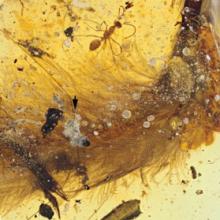Researchers published a paper about a feathered-tail encased in amber that's 99 million years old. This study is important because the structures aren't flattened, as tends to happen with traditional stone fossils.
Here's part of the summary.
This specimen provides an opportunity to document pristine feathers in direct association with a putative juvenile coelurosaur, preserving fine morphological details, including the spatial arrangement of follicles and feathers on the body, and micrometer-scale features of the plumage. Many feathers exhibit a short, slender rachis with alternating barbs and a uniform series of contiguous barbules, supporting the developmental hypothesis that barbs already possessed barbules when they fused to form the rachis [19]. Beneath the feathers, carbonized soft tissues offer a glimpse of preservational potential and history for the inclusion; abundant Fe2+ suggests that vestiges of primary hemoglobin and ferritin remain trapped within the tail. The new finding highlights the unique preservation potential of amber for understanding the morphology and evolution of coelurosaurian integumentary structures.
Now, what's happening with this is fairly dense. They're analyzing the fine points about the structures of "feathers" of this one species at this one time. This example is a data point about what aspects of feathers existed, when, and with what creatures.
What the average layperson is going to struggle with - is how this "proves" evolution. Many people seem to require smoking-gun singular "proofs" of a thing, but that's not really how science works.
The evolutionary history of feathers is like a large jigsaw puzzle, and in this case, we've snapped another piece into place. It's not one of those flat-colored pieces that are fairly ambiguous... it's a useful and notable puzzle piece.
It's an interesting and useful find, however, let's not overplay its value.
Looking at the photos, I can put on my creationist (stone) hat. "Look, you can clearly see ants! See? Evolution doesn't happen. It's right next to feathers which clearly haven't evolved into a different type either!"
It's one of those common misconceptions about evolution - that all lineages must be evolving into something "better" and "more advanced". It'd be like saying that our understanding of cars means the car must always be moving, and idling is not possible (and they definitely can't go in reverse!)
The problem is how humans tend to try to categorize things. If we had one of those "ants" and tried to mate it with a modern day "ant", we'd probably find they couldn't, and are therefore a different species. The embalmed version may be a distant ancestor, or its lineage may have gone extinct. We have to go deeper than superficial appearances to say whether they're closely related on the evolutionary tree.
That's where we get into the mysterious creationist "kind" that has no strict definition, and always seems to shift depending on the mood of the creationist. "Ants", as a "kind" will always exist within the evolutionary model, in the same sense that "bacteria" always will - because it's a niche that works well. That "kind" will always be filled by one or more species. Evolution doesn't have a problem with this.
I'm cautious about looking at evolutionary samples like this - while the scientists are looking at one thing, the creationists will be looking at another. They'll weave their own narrative based on a framework of misconceptions.

